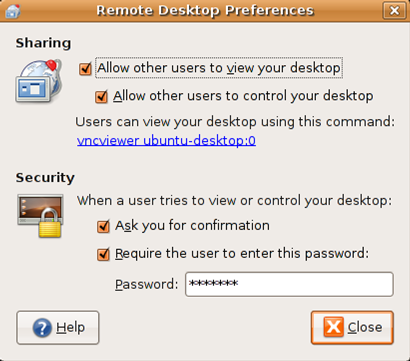
- #REMOTER VNC BACKUP CONFIG HOW TO#
- #REMOTER VNC BACKUP CONFIG FOR MAC#
- #REMOTER VNC BACKUP CONFIG INSTALL#
- #REMOTER VNC BACKUP CONFIG UPDATE#
- #REMOTER VNC BACKUP CONFIG PASSWORD#
Once it’s installed, you’ll find the TightVNC Viewer in your Start menu.
#REMOTER VNC BACKUP CONFIG INSTALL#
TightVNC includes a VNC client – you can install TightVNC on another computer and deselect the server option in the install process to only install the viewer. With a VNC server running on the remote computer, you can use a VNC client on another computer to connect.
#REMOTER VNC BACKUP CONFIG HOW TO#
Read More: How To Easily Access Your Home Network From Anywhere With DDNS.Internet service providers often change the IP address assigned to home networks, which means that you may be unable to connect to your home computer if your home IP address changes. You may also want to set up a dynamic DNS hostname for your home network. Read More: How To Forward Ports on Your Router.This process is different on every router, but you’ll have to use your router’s web interface to forward ports. If you want to connect to it from the Internet, you’ll have to do a few more things.įirst, you’ll need to forward the VNC server’s port on your router. Your computer is now running a VNC server, so you’ll be able to connect to it from other computers on your local network. You may also want to change the Web Access port for the same reason - or disable web access entirely.
#REMOTER VNC BACKUP CONFIG FOR MAC#
No need to buy more days, just buy once, and use forever Remoter for Mac: Now available for Mac (for only 14.99) in the Mac App Store or Directly from us VNC is the Industry-Standard for remote desktop, and is already integrated into Mac OS X. People scanning for open VNC servers will try t o connect at port 5900, ut generally won’t notice VNC servers running on other random ports, such as 34153. Get Remoter VNC for iOS for only US 3.99 right now, and use it on all your iDevices. The default port used for VNC is 5900 – you can increase your security by changing it to another port. It means that you can work on a remote computer, as if you were sitting in front of it. The program allows you to use your mouse and keyboard to control the other PC remotely. One important setting you’ll want to change is the ports TightVNC uses. UltraVNC is a powerful, easy to use and free - remote pc access softwares - that can display the screen of another computer (via internet or network) on your own screen. You can use the TightVNC Service – Control Interface option in your Start menu to configure your server.

When disaster strikes, Redo Rescue restores your system to perfect condition in minutes. (Of course, you can always disable the service manually.) It also automatically allows itself in the Windows firewall – if you use a different firewall, ensure that the firewall isn’t blocking TightVNC or you won’t be able to connect.īe sure to secure your VNC with a strong password, especially if you’re exposing your VNC server to the Internet!Īfter the quick installation process, TightVNC will now be running on your computer. Bare-metal backup and restore is just a few clicks away. X-terminal-emulator -geometry 80x24+10+10 -ls -title "$VNCDESKTOP Desktop" &Īnd just to be sure, we’ll make it executable sudo chmod +x ~/.TightVNC installs itself as a system service by default, so it will always be running in the background as long as your computer is on. Raf: Is it possible to print a sorted Sessions List (Server Type, Name, VNC Hostname, VNC Port, Password, MAC Address, VNC Advanced Settings - including MAC Address and Broadcast IP) Or perhaps send this data to a text file to be exported to a PC, or USB Stick, or pasted into an iPhone note. The configuration of this file is generally not too complex, I have had some problem in running the window manager but in this end this version was the right one for me: #!/bin/sh vnc: we can backup the xstartup file (into something like xstartup.bak) and we can edit it with our preferred editor: jed ~/.vnc/xstartup

Now, before we go on, we have to kill the running server instance: vncserver -kill :1Īnd we can proceed configuring the server the configuration files are in the user sub-directory.
#REMOTER VNC BACKUP CONFIG PASSWORD#
This will optionally let us also add a “view-only” password (sessions in which the VNC Client cannot interact with mouse or keyboard). In the current situation you make a reference to a local file on your. Once installed we can run vncserver to setup a password: vncserver The possibility for a VNC session to save the configuration file in the database. We’ll then install the tightvnc server: sudo apt-get install tightvnc
#REMOTER VNC BACKUP CONFIG UPDATE#
For my Odroid U3 I wanted a default startup into a console login session to have the maximum amount of resources available but I also wanted a VNC Server configured so that I can start (and stop) a graphical session whenever I want.Īs usual, the first thing to do (not strictly necessary but it’s always a good idea) is to update the packages to the most recent versions: sudo apt-get update & sudo apt-get upgrade Using Apache Guacamole in combination with VNC for clientless Linux remote access - clientless-linux-remote-access.


 0 kommentar(er)
0 kommentar(er)
